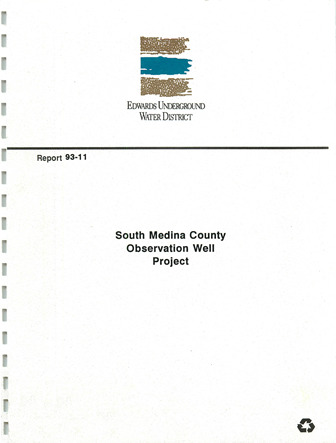South Medina County Observation Well Project

| Author | Waugh JR |
| Year | 1993 |
| Description | Drilling and evaluation of a new test well in South Medina County to refine the location of the freshwater / saline water interface in the Edwards Aquifer interface between San Antonio and Uvalde, Texas |
| Report Number | 93-11 |
| Publisher | Edwards Underground Water District |
| Location | Edwards Aquifer, Balcones Fault Zone, San Antonio Segment, Medina County |
| Cover | View Download |
| File | View Download |
| Summary |
|
In 1992, the Board of Directors of the Edwards Underground Water District released Report No. 92-03, written by Mr. Alvin L. Schultz. [qv] The report summarizes the results of a study designed to better define the freshwater/saline-water interface between San Antonio and Uvalde, Texas. Mr. Schultz utilized the evaluation of water quality data calculated from geophysical logs in order to determine that the freshwater/saline-water interface in this area is actually located further south than previously mapped. Based on the results of the study, a location was chosen to evaluate Mr. Schultz’s conclusions by drilling and testing an Edwards aquifer observation well in an area where the current and proposed interfaces were several miles apart. The well location was also chosen in an area with good geophysical log control, but with very little measured water quality data available. The referenced observation well location is in southwest Medina County (Figure 1), approximately four and one-half miles southwest of Yancey, Texas. The well is located approximately three miles south of the currently mapped interface…. The South Medina County well encountered fresh water, as defined by measured total dissolved solids, throughout the Edwards aquifer section to total depth of the well. Analyses of the water samples obtained from different depths indicate fairly uniform quality, with the highest TDS values occurring in the uppermost zone tested. This suggests that any wells drilled in this area should drill at least 200-250 feet of Edwards porosity to obtain good quality water. Sulfate concentration in the water can be lowered by aeration. Significance of detectable chromium found in the well will need to be further evaluated. The South Medina County Observation Well is completed with the entire Edwards aquifer section open for future monitoring and testing. A pressure transducer is being installed to monitor hydrostatic pressure changes in the aquifer at this location. Future testing should include a pumping test conducted at a pumping rate far in excess of 300 gal/min in order to produce measurable drawdown and subsequent recovery. Water quality samples should be obtained on a quarterly to semi-annual basis to evaluate changes in quality as aquifer levels fluctuate. If water quality changes are noted, discrete intervals should be sampled in the well. The final conclusion of this project is that the freshwater/ saline-water interface in this portion of the Edwards aquifer is located to the south of the South Medina County Observation Well. Refinement of the calculated data from Report 92-03, utilizing measured versus calculated data from this project, should better define the interface in western Medina and Frio counties. The data and conclusions will also be forwarded to the Texas Natural Resources Conservation Commission with the recommendation that the position of the freshwater/saline-water interface should be re-evaluated in light of the new data made available by this project. |
Search for Documents
Advance Search
Explore EAA's Scientific Reports
- All Reports
- Remote Sensing
- Precipitation
- Overview Studies
- Modeling
- Hydrology and Hydrogeology
- History
- Groundwater Recharge, Recharge Zone
- Groundwater Movement
- Geomorphology and Caves
- Weather Modification
- Geology
- Water Use and Conservation
- Geochemistry
- Water Resources Planning and Management
- Floods and Drought
- Water Quality
- Climatology
- Surface Water / Groundwater Relationship
- Biology
- Springs, Groundwater Discharge
- Archaeology
- RZ Protection
- Aquifer Levels
